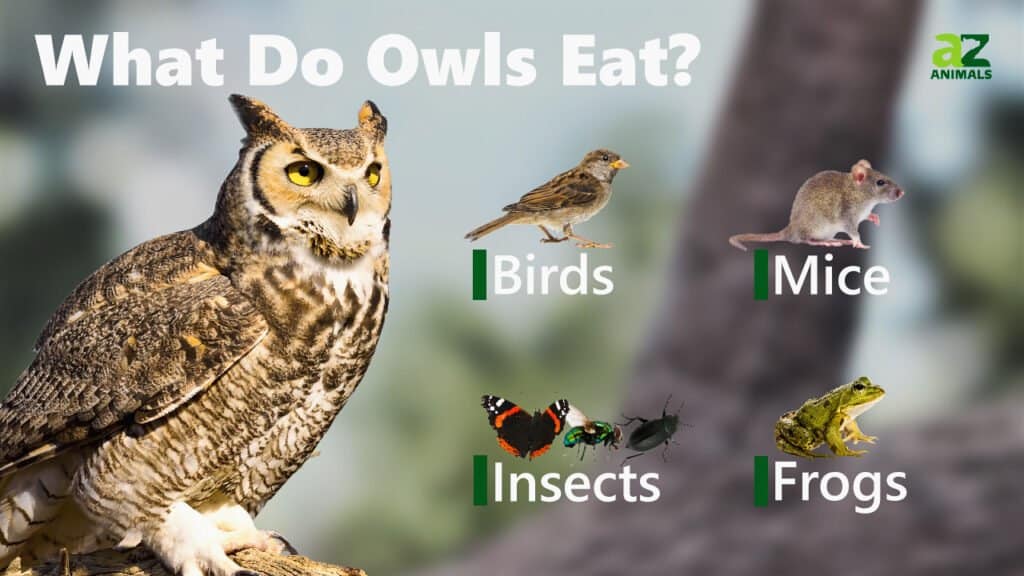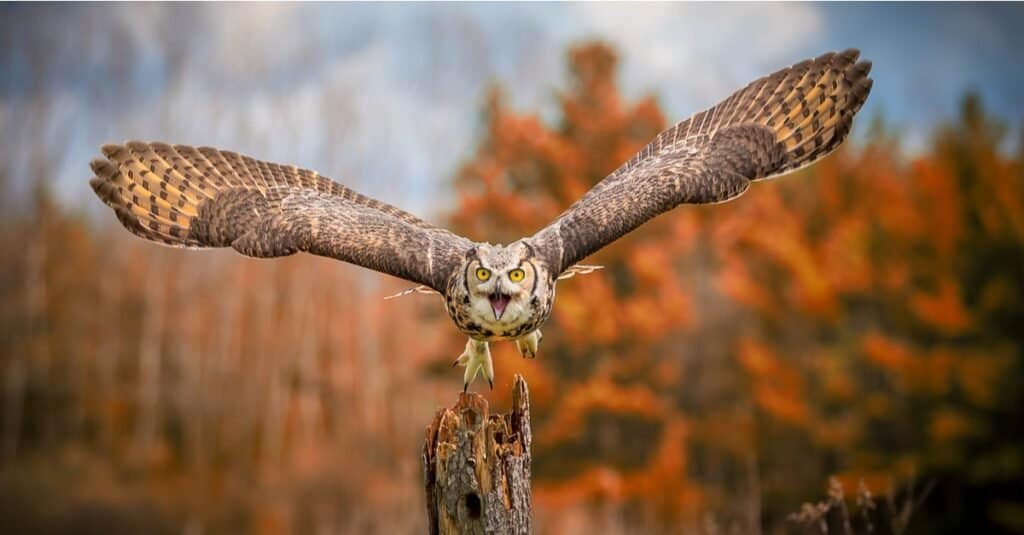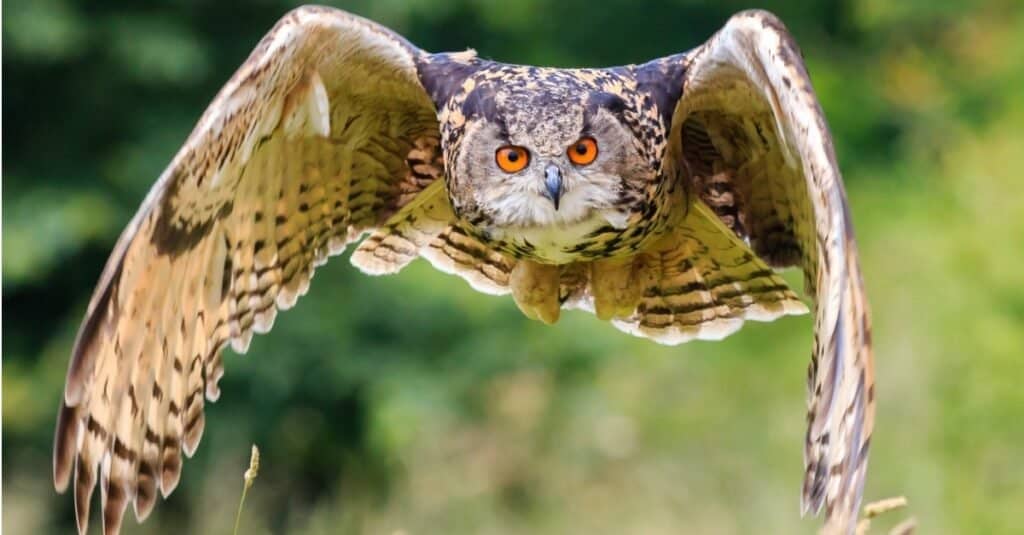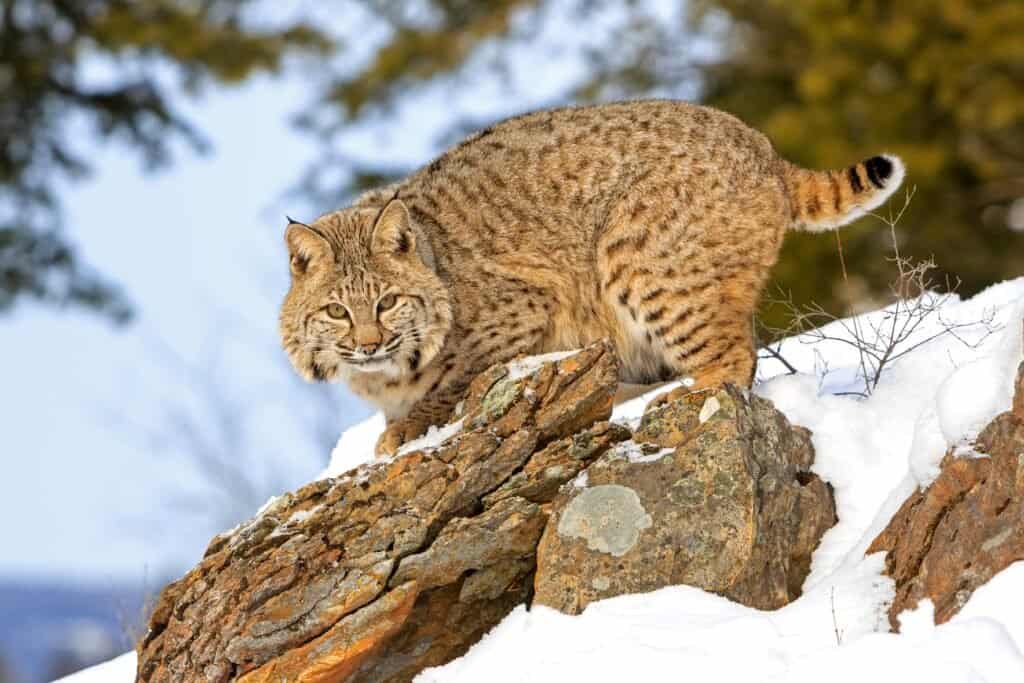The great horned owl is a powerful bird of prey with distinctive features, straight out of a children’s picture book. These wise old owls have long tufts of feathers on the sides of their heads, large yellow eyes, and deep voices for hooting. Great horned owls, or hoot owls, are distributed across North and South America. However, it’s rare to catch sight of them. Often, you will find them perched on a tree limb or hiding in a rocky cave. This owl species is highly adaptable and lives, hunts, and eats all over the Americas, including Alaska. Keep reading to find out what great horned owls eat!
What Do Great Horned Owls Eat?

The great horned owl eats a varied diet depending on its location. However, small mammals make up most of these owls’ food sources. They hunt for mice, rats, ground squirrels, and rabbits during winter. These fierce predators will often prey on other birds, including smaller owls. You can expect to see great horned owls feasting on geese, hawks, and ducks, especially in the northern region of the Americas. While these owls rarely eat fish and amphibians, some may take advantage of the abundant and ready supply if nesting near water sources. Insects and reptiles complete this bird’s well-balanced diet. It is not uncommon for great horned owls to dine on snakes and scorpions.
A Complete List of Foods Great Horned Owls Eat
Below are the most common foods great horned owls enjoy:
- Mice
- Rats
- Squirrels
- Rabbits
- Snowshoe hares
- Opossums
- Skunks
- Hawks
- crows
- Small owls
- Ducks
- Geese
- Snakes
- Frogs
- Lizards
- Insects
- Scorpions
- Fish (occasionally)
While great horned owls stick with smaller prey, they can lift mammals and birds up to 15 pounds!
These owls often have fewer food options during the winter and will hunt what is readily available, such as snowshoe hares and certain birds.
How Does a Great Horned Owl Hunt?

A great horned owl flies completely silent, swooping down to grab its prey.
©Imran Ashraf/Shutterstock.com
Great horned owls are birds of prey and are fierce and excellent hunters. These birds threaten many creatures in the animal kingdom and come equipped with specialized features for hunting. They are nocturnal and hunt mostly at night and during dusk. Their eyesight is superb in low-light conditions, and their hearing is sensitive to small prey.
One of the essential advantages this predator has over other birds like hawks is that it flies completely silent. Their large, serrated wings allow the owl to glide slow and free of sound. Prey doesn’t know what’s coming until it’s too late. One undetected swoop and tiny mammals are caught in the owl’s strong talons with no way to escape. A force of 28 pounds is needed to open the great horned owl’s claws. This death grip can quickly sever a spine.
These predators watch for their dinner from tree limbs or fence posts. With prey in sight, they swoop down low over fields, reaching out their talons and tightly grasping hold of their meal.
Who Competes with Great Horned Owls for Food?

Birds of prey compete for food and nesting spots.
©Wang LiQiang/Shutterstock.com
Great horned owls are near the top of the food chain, but that doesn’t mean they don’t have to compete for food. Other owl species, hawks, and eagles eat a similar diet to great horned owls. Birds of prey compete for food and nesting spots frequently. However, the great horned owl employs various tactics to avoid competition.
Hunting at night makes it easier for great horned owls to obtain food and keeps other birds from getting prey first. They also eat their food whole and immediately (unless hunting for their young) to prevent others from stealing it.
How Does Their Diet Impact Other Species?

Great horned owls help balance the ecosystem by eating rodents and other pests.
©Rudmer Zwerver/Shutterstock.com
The great horned owl is a predator and controls the population of small animals. These owls play an essential role in balancing the ecosystem by eating rodents and other pests. Rodents like mice and rats eat and spoil a staggering number of crops throughout the United States and the world. Rodents can also cause structural damage to homes and other buildings. Great horned owls help keep rodent numbers down, which is incredibly beneficial to humans.
Before you consider attracting these majestic predators to your property, you may want to reconsider if you have small animals like chickens, cats, and dogs. Remember, great horned owls hunt prey that weighs much more than they do.
What Do Different Types of Owls Eat?

Owls are opportunistic hunters and eat what is available in their geographic location.
©Richard Whitcombe/Shutterstock.com
Out of all the North American raptors, the great horned owl has the most diverse diet. Its favorite foods include snowshoe hares, mice, rabbits, squirrels, and other birds. But not all owls share the same diet.
Screech owls (short, stalky birds) prefer insects, slugs, snails, and amphibians. In comparison, large species like the eagle owl hunt foxes, ducks, and rabbits.
Owl diets depend primarily on their location and the characteristics of their bodies. Owls are opportunistic hunters and will search for available food in their geographic location. Small, domesticated animals like cats and dogs can become prey if the opportunity arises.
What Do Baby Great Horned Owls Eat?
Baby great horned owls are carnivores like their parents and will eat whatever is provided. The adults (male and female) bring back different meat sources to the nests for their young.
A baby’s diet typically includes small mammals, reptiles, birds, worms, insects, and fish. The babies can fly out of the nest at around nine to 10 weeks but will still be fed and cared for by the parents for several more months.
Do Great Horned Owls Have Any Predators?

Great horned owls can fall victim to foxes, coyotes, and bobcats.
©Jack Bell Photography/Shutterstock.com
Because great horned owls lack major predators, it is rare for an adult to be attacked. But there are instances where these owls may need to defend themselves over food and territory.
Great horned owls can fall prey to animals like foxes, coyotes, and bobcats. Attacks from these predators often happen out in the open when the owl is mantling or covering prey. Other birds of prey, like golden eagles and northern goshawks, can also pose a threat to adults. However, young great horned owls are the most vulnerable. The babies can fall victim to other raptors and birds.
The photo featured at the top of this post is © Imran Ashraf/Shutterstock.com
Thank you for reading! Have some feedback for us? Contact the AZ Animals editorial team.







